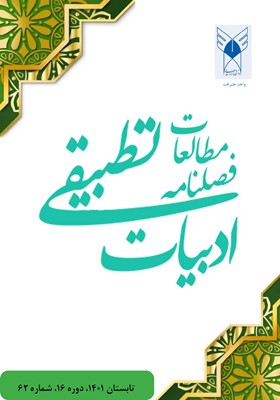مطالعه تطبیقی هنجار گریزی معنایی در اشعار ژاله اصفهانی و غادة السّمّان
محورهای موضوعی : شعرزینب خطیری 1 , سید فضلالله رضوی پور 2 , آرش مشفقی 3
1 - دانشجوی دکتری زبان و ادبیات فارسی دانشگاه آزاد اسلامی واحد بناب
2 - استادیار گروه زبان و ادبیات عرب دانشگاه آزاد اسلامی واحد بناب
3 - استادیار گروه زبان و ادبیات فارسی دانشگاه آزاد اسلامی واحد بناب
کلید واژه: شعر, هنجار گریزی, غادة السّمّان, استعاره,
چکیده مقاله :
هنجار گریزی یکی از نظریههای ادبی و تأثیرگذارترین روشها در برجستهسازی ادبی میباشد که در عرصه شعر بازخورد زیادی دارد. نظریه فرمالیستها بر این باور است که انسان همواره با دو نوع زبان در ارتباط است. اولی زبان عادی که انتقالدهنده پیامهای روزمره است و زبان ادبی که در قلمرو هنر و ادبیات استعمال میشود و ظرافت خاص خود را دارد. آشناییزدایی همواره لذتهای ادبی را برای مخاطب برقرار میسازد و قدرت حواس آدمی را بهبود میبخشد. پژوهش حاضر در نظر دارد با شیوهای توصیفی - تحلیلی و تکیه بر اشعار ژاله اصفهانی و غادة السّمّان به مقوله هنجار گریزی معنایی و گونههای مختلف آن بپردازد و به این سؤال پاسخ دهد که هنجار گریزی معنایی چیست و حوزههای بسترساز این هنجار در اشعار ژاله اصفهانی و غادة السّمّان علیرغم وجوه اشتراک و افتراق چگونه به کار رفته است؟ یافتههای پژوهش از راه جستجوی کتابخانهای نشان میدهد که ژاله اصفهانی و غادة السّمّان هر دو از صور خیال و آرایههای معنوی بهرهمند گردیدهاند.
Abnormality is one of the literary theories and one of the most effective methods in literary highlighting that has a lot of feedback in the field of poetry. Formalist theory holds that man is always associated with two kinds of language. The first is ordinary language, which conveys everyday messages, and literary language, which is used in the realm of art and literature and has its own delicacy. De-familiarization always establishes literary pleasures for the audience and improves the power of the human senses. The present study intends to deal with the category of semantic aberration and its different types with descriptive-analytical methods and relying on the poems of zhaleh Esfahani and Ghada Al-Samman and to answer the question of what semantic aberration is. And how is the bedrock of this norm used in the poems of zhaleh Esfahani and Ghada Al-Samman despite the commonalities and differences? Findings of the research through library search show that zhaleh Esfahani and Ghada Al-Samman have both benefited from imaginary forms and spiritual arrays.
اصفهانی، ژاله. 1384ش. مجموعه اشعار. چ 1. تهران: انتشارات نگاه.
بارانی، محمد. 1382ش. «کارکرد ادبی زبان و گونههای آن». مجلهی فرهنگ. شماره 46 -47، صص 55-70.
پور نامداریان، تقی. 1381ش. سفر در مه. چ 1. تهران: نگاه.
_||_اصفهانی، ژاله. 1384ش. مجموعه اشعار. چ 1. تهران: انتشارات نگاه.
بارانی، محمد. 1382ش. «کارکرد ادبی زبان و گونههای آن». مجلهی فرهنگ. شماره 46 -47، صص 55-70.
پور نامداریان، تقی. 1381ش. سفر در مه. چ 1. تهران: نگاه.
ریما مکاریک، ایرنا. 1384ش. دانشنامهی نظریههای ادبی معاصر. ترجمۀ مهران مهاجر و محمد نبوی. چ 1. تهران: نشر آگه.
سجودی، فرزان. 1387ش. نشانهشناسی کاربردی. تهران: علم.
السّمّان، غادة 1377ش. غمنامهای برای یاسمنها، ترجمه: عبدالحسین فرزاد، تهران: چشمه.
السّمّان، غادة 1383ش. ابدیت، لحظه عشق، ترجمهی عبدالحسین فرزاد، تهران: چشمه.
السّمّان، غادة 1387 ش. غمنامهای برای یاسمنها، ترجمهی عبدالحسین فرزاد، تهران: چشمه.
السّمّان، غادة 1998ق. الحبّ من الورید، الطبعة العاشرة، منشورات غادة السّمّان، بیروت.
السّمّان، غادة 1999ق. عاشقة فی محبرة، الطبعة الثانیة، بیروت: منشورات غادة السّمّان
شفیعی کدکنی، دکتر محمدرضا. 1390ش. صور خیال در شعر فارسی. چ 14. تهران: نشر آگه.
صفوی، کورش. 1390ش. از زبانشناسی تا ادبیات. ج 1. چ 3. تهران: انتشارات سوره مهر.
عابدی، کامیار. 1380ش. بهرغم پنجرههای بسته: شعر معاصر زنان. چ 1. تهران: انتشارات کتاب نادر.
عبدالقاهر جرجانی. 1370ش. اسرار البلاغه. ترجمۀ جلیل تجلیل. تهران: دانشگاه تهران.
فتوحی، محمود. 1391ش. سبکشناسی. تهران: سخن.
قریب، عبدالعظیم، و دیگران. 1366ش. دستور زبان فارسی پنج استاد. چ 4. تهران: انتشارات اشرفی.
گرجیان ،بهمن و عباس زاده ،فرنگیس.1399ش.ساختار شکنی و هنجارگریزی تطبیقی نحوی ، واژگانی و زمانی در شعرپروین اعتصامی،فصلنامه مطالعات ادبیات تطبیقی ،سال چهاردهم،شماره55صص،53-37
میویک، دسی. 1987ق. المفارقة و صفاتها. ترجمۀ عبدالواحد لؤلؤة. بغداد: دارالامأمون للترجمة و النشر.
Reference
Leech, Geoffrey N. (1969). A linguistic guide to English poetry. Harlow, Longma.
Abdul Qaher Jarjani (1370)Secrets of rhetoric. Translated by Jalil Tajil. Tehran: University of Tehran.
Abedi, Kamyar. (1380). Despite the closed windows: Contemporary women's poetry. Ch 1. Tehran: Nader Book Publishing.
Barani, Mohammad (1382). "Literary function of language and its types". Journal of Culture. No. 46-47, pp. 55-70.
Fotuhi, Mahmoud (1391). Stylistics. Tehran: Sokhan.
Georgian, Bahman and Abbaszadeh, Farangis. 1399. Syntactic, lexical and temporal comparative deconstruction and aberration in Parvin Etesami's poetry, Quarterly Journal of Comparative Literature Studies, Fourteenth Year, No. 55, pp. 53-37
Ghada Al-Samman (1384)Eternity, the moment of love, translated by Abdolhossein Farzad, Tehran: Cheshmeh.
Ghada Al-Samman(1377) Love in Love, Second Printing, Beirut: Al-Saman Newsletter Publications.
Ghada Al-Samman(1377) The love of the heart, the tenth edition, the publications of the sky, Beirut.
Ghada Al-Samman(1383) Grief for Jasmines, translated by Abdolhossein Farzad, Tehran: Cheshmeh.
Ghada Al-Samman(1387) Grief for Jasmines, translated by Abdolhossein Farzad, Tehran: Cheshmeh.
Gharib, Abdul Azim, and others. (1366). Persian grammar of five masters. Ch 4. Tehran: Ashrafi Publications.
Isfahani, zhaleh. (1384). Collected Poems. Ch 1. Tehran: Negah Publications.
Leech, Geoffrey N. (1969). A linguistic guide to English poetry. Harlow, Longmans.
Miwick, Desi. (1987). The differences and their attributes. Translated by Abdul Wahed Lulu. Baghdad: Dar al-Amun for translation and publication.
Poor Namdarian, Taghi. (1381). Travel in May. Ch 1. Tehran: Negah.
Rima Makarik, IRNA. (1384). Encyclopedia of Contemporary Literary Theories. Translated by Mehran Mohajer and Mohammad Nabavi. Ch 1. Tehran: Publishing.
Safavid, Cyrus. (1390). From linguistics to literature. C 1. Ch 3. Tehran: Surah Mehr Publications.
Shafiee Kadkani, Dr. Mohammad Reza. (1390). Imagination in Persian poetry. Ch 14. Tehran: Publishing.
Sujudi, Farzan. (1387). Applied semiotics. Tehran: Science.


